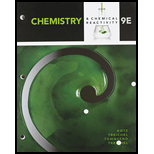
Interpretation:
For the given reaction, the value of
Concept introduction:
The change in the enthalpy of a reaction when reactant is converted into product under standard conditions is called standard enthalpy of reaction.
The expression for standard enthalpy of reaction is,
Here,
Explanation of Solution
The value of
Given:
Refer to Appendix L for the values of standard enthalpy of formation.
The standard enthalpy of formation of
The standard enthalpy of formation of
The standard enthalpy of formation of
The standard enthalpy of formation of
The given balanced chemical equation is:
The
Substitute the value of
The value of
Want to see more full solutions like this?
Chapter 24 Solutions
Bundle: Chemistry & Chemical Reactivity, Loose-Leaf Version, 9th + OWLv2, 4 terms (24 Months) Printed Access Card
- Solid NH4NO3 is placed in a beaker containing water at 25 C. When the solid has completely dissolved, the temperature of the solution is 23.5 C. (a) Was the process exothermic or endothermic? (b) Was the process spontaneous? (c) Did the entropy of the system increase? (d) Did the entropy of the universe increase?arrow_forwardEnthalpy changes often help predict whether or not a process will be spontaneous. What type of reaction is more likely to be spontaneous: an exothermic or an endothermic one? Provide two examples that support your assertion and one counterexample.arrow_forwardA green plant synthesizes glucose by photosynthesis, as shown in the reaction: 6CO2(g) + 6H2O(l) C6H12O6(s) + 6O2(g) Animals use glucose as a source of energy: C6H12O6(s) + 6O2(g) 6CO2(g) + 6HO2(l) If we were to assume that both of these processes occur to the same extent in a cyclic process, what thermodynamic property must have a nonzero value?arrow_forward
- What is meant by the standard free-energy change G for a reaction? What is meant by the standard free energy of formation Gf of a substance?arrow_forwardWhen most biological enzymes are heated, they lose their catalytic activity. This process is called denaturing. The change original enzyme new form that occurs on heating is endothermic and spontaneous. Is the structure of the original enzyme or its new form more ordered (has the smaller positional probability)? Explain.arrow_forwardUsing values of fH and S, calculate the standard molar free energy of formation, fG, for each of the following compounds: (a) CS2(g) (b) NaOH(s) (c) ICl(g) Compare your calculated values of fG with those listed in Appendix L Which of these formation reactions are predicted to be product-favored at equilibrium at 25 C?arrow_forward
- One statement of the second law of thermodynamics is that heat cannot be turned completely into work. Another is that the entropy of the universe always increases. How are these two statements related?arrow_forward10.102 Ammonia can react with oxygen gas to form nitrogen dioxide and water. (a) Write a balanced chemical equation for this reaction. (b) Use tabulated data to determine the free energy change for the reaction and comment on its spontaneity. (c) Use tabulated data to calculate the enthalpy change of the reaction, (d) Determine how much heat flows and in what direction when 11.4 g of ammonia gas is burned in excess oxygen.arrow_forwardWhat is entropy? Why is entropy important?arrow_forward
- Coal is used as a fuel in some electric-generating plants. Coal is a complex material, but for simplicity we may consider it to be a form of carbon. The energy that can be derived from a fuel is sometimes compared with the enthalpy of the combustion reaction: C(s)+O2(g)CO2(g) Calculate the standard enthalpy change for this reaction at 25C. Actually, only a fraction of the heat from this reaction is available to produce electric energy. In electric generating plants, this reaction is used to generate heat for a steam engine, which turns the generator. Basically the steam engine is a type of heat engine in which steam enters the engine at high temperature (Th), work is done, and the steam then exits at a lower temperature (Tl). The maximum fraction, f, of heat available to produce useful energy depends on the difference between these temperatures (expressed in kelvins), f = (Th Tl)/Th. What is the maximum heat energy available for useful work from the combustion of 1.00 mol of C(s) to CO2(g)? (Assume the value of H calculated at 25C for the heat obtained in the generator.) It is possible to consider more efficient ways to obtain useful energy from a fuel. For example, methane can be burned in a fuel cell to generate electricity directly. The maximum useful energy obtained in these cases is the maximum work, which equals the free-energy change. Calculate the standard free-energy change for the combustion of 1.00 mol of C(s) to CO2(g). Compare this value with the maximum obtained with the heat engine described here.arrow_forwardAt 298 K, the standard enthalpies of formation for C2H2(g) and C6H6(l) are 227 kJ/mol and 49 kJ/mol, respectively. a. Calculate H for C6H6(l)3C2H2(g) b. Both acetylene (C2H2) and benzene (C6H6) can be used as fuels. Which compound would liberate more energy per gram when combusted in air?arrow_forwardHow does the second law of thermodynamics explain a spontaneous change in a system that becomes more ordered when that process is exothermic?arrow_forward
 Chemistry: The Molecular ScienceChemistryISBN:9781285199047Author:John W. Moore, Conrad L. StanitskiPublisher:Cengage Learning
Chemistry: The Molecular ScienceChemistryISBN:9781285199047Author:John W. Moore, Conrad L. StanitskiPublisher:Cengage Learning Chemistry for Today: General, Organic, and Bioche...ChemistryISBN:9781305960060Author:Spencer L. Seager, Michael R. Slabaugh, Maren S. HansenPublisher:Cengage Learning
Chemistry for Today: General, Organic, and Bioche...ChemistryISBN:9781305960060Author:Spencer L. Seager, Michael R. Slabaugh, Maren S. HansenPublisher:Cengage Learning ChemistryChemistryISBN:9781305957404Author:Steven S. Zumdahl, Susan A. Zumdahl, Donald J. DeCostePublisher:Cengage Learning
ChemistryChemistryISBN:9781305957404Author:Steven S. Zumdahl, Susan A. Zumdahl, Donald J. DeCostePublisher:Cengage Learning Chemistry & Chemical ReactivityChemistryISBN:9781337399074Author:John C. Kotz, Paul M. Treichel, John Townsend, David TreichelPublisher:Cengage Learning
Chemistry & Chemical ReactivityChemistryISBN:9781337399074Author:John C. Kotz, Paul M. Treichel, John Townsend, David TreichelPublisher:Cengage Learning Chemistry & Chemical ReactivityChemistryISBN:9781133949640Author:John C. Kotz, Paul M. Treichel, John Townsend, David TreichelPublisher:Cengage Learning
Chemistry & Chemical ReactivityChemistryISBN:9781133949640Author:John C. Kotz, Paul M. Treichel, John Townsend, David TreichelPublisher:Cengage Learning





